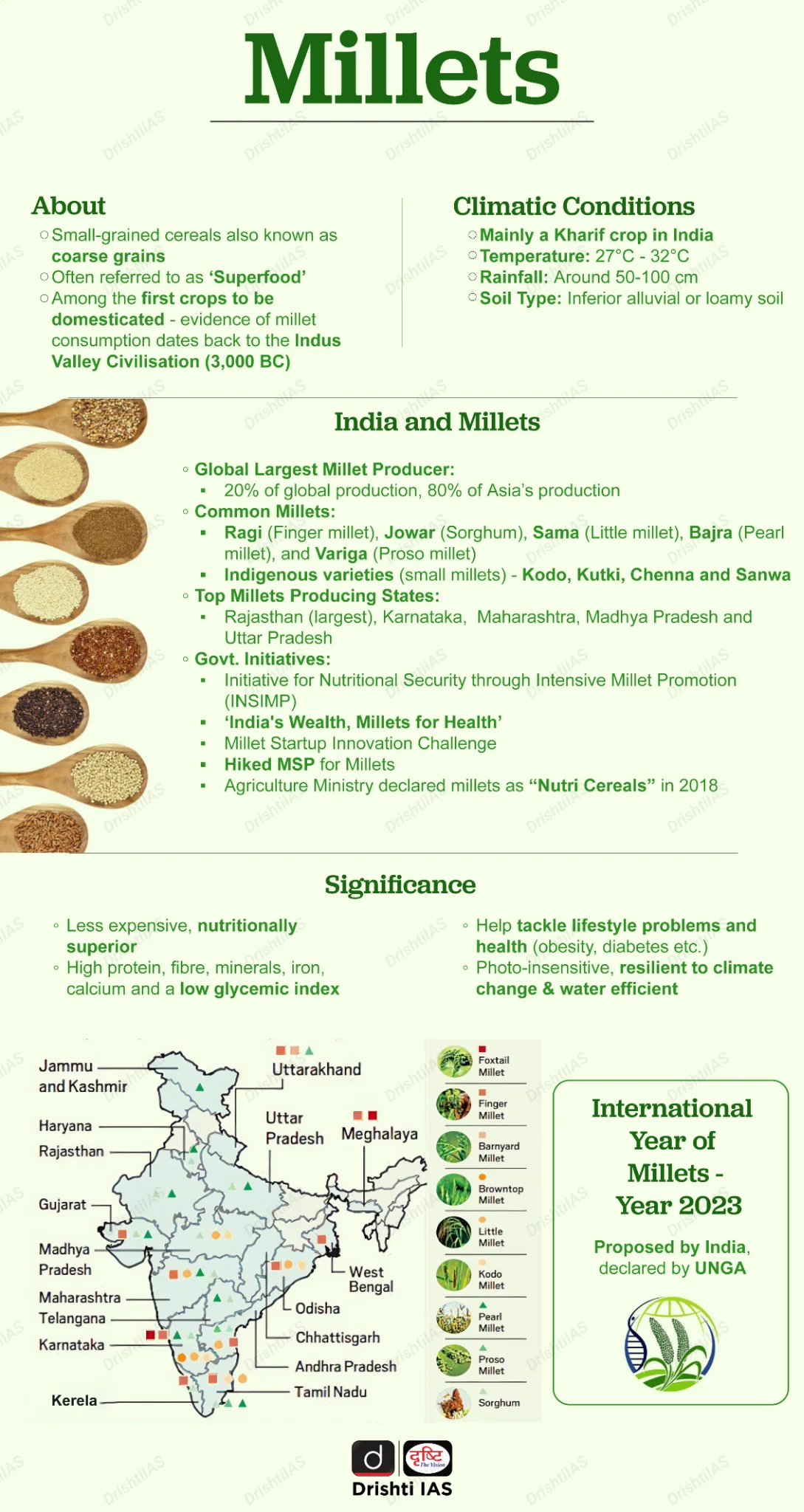India’s Millet Standards Recognised at Codex Alimentarius Commission | 23 Jul 2025
Why in News?
India’s leadership in developing a group standard for whole millet grains was appreciated during the 88th Session of the Executive Committee of the Codex Alimentarius Commission (CAC) 2025, held at the Food and Agriculture Organization (FAO) headquarters in Rome, Italy.
What is the Codex Alimentarius Commission (CAC)?
- About: CAC is an international food standards body established jointly by the FAO and the World Health Organization (WHO) in 1963 with the objective of protecting consumer's health and ensuring fair practices in food trade.
- The CAC has 189 members. India joined in 1964.
- Codex Alimentarius: The Codex Alimentarius, or "Food Code", is a collection of standards, guidelines, and codes of practice adopted by the CAC.
- It sets standards for all major foods (processed, semi-processed, or raw) and covers areas like hygiene, additives, residues, contaminants, labelling, and inspection.
- Codex standards guide food safety trade disputes under the World Trade Organization (WTO) Agreement on the Application of Sanitary and Phytosanitary Measures (SPS Agreement).
- India and CAC: India actively engaged in discussions around the Codex Strategic Plan 2026–2031, advocating for SMART (Specific, Measurable, Achievable, Relevant, Time-bound) Key Performance Indicators.
- Since 2014, India has chaired the Codex Committee on Spices and Culinary Herbs, and led the development of global standards for millets, fresh dates, and India will also serve as co-chair in new work proposals to develop standards for fresh turmeric and broccoli. It also promoted Codex Trust Fund use for capacity building.
What are Millets, and How is India Leading their Promotion?
- Millets: Millets, also known as Shree Anna, are small cereal grains grown mainly as a Kharif crop and belong to the Poaceae (grass) family.
- Significance: The United Nations General Assembly, based on a proposal by India, declared 2023 as the International Year of Millets (IYM).
- Millets are more nutritious than wheat and rice, being rich in protein, vitamins, and minerals. They are gluten-free with a low glycemic index, suitable for celiac and diabetic patients.
- As climate-resilient crops, millets require less water and can grow in poor soils, making them ideal for sustainable agriculture.
- India’s Standards on Millets: The Food Safety and Standards Authority of India (FSSAI) has framed group standards for 15 types of millets, specifying 8 quality parameters i.e., maximum limits for moisture content, uric acid content, extraneous matter, other edible grains, defects, weevilled grains, immature grains, and shriveled grains.
- These standards form an important foundation for developing global standards.
- India’s Position in Millets Production: India is the largest producer of millets, contributing 38.4% of global production (FAO, 2023).
- India grows a wide range of millets including sorghum (jowar), pearl millet (bajra), finger millet (ragi) and others like foxtail, barnyard, kodo, and proso millet.
- The total area under millet cultivation in FY24 was 12.19 million hectares, producing 15.38 million metric tonnes.
- Rajasthan leads in both area and production, followed by Uttar Pradesh, Karnataka, and Maharashtra.
- Exports: India exported 1.46 lakh metric tonnes of millets in FY24, earning USD 70.89 million. Key export destinations include the UAE, Saudi Arabia, USA, Japan, and Nepal.
- India’s Initiatives to Promote Millets:
- Production Linked Incentive Scheme for Millet-Based Products (PLISMBP) (2022–2027): The PLISMBP incentivizes companies producing Ready-to-Eat/Cook products with ≥15% millet content.
- Sub-Mission on Nutri-Cereals (Millets) under NFSM: Covers 28 States and 2 UTs, promoting major, minor, and pseudo-millets like buckwheat and amaranth.
- It provides farmers with incentives for seed production, better farming techniques, tools, and awareness training.
- Nutrition and Public Distribution: Millets added under TPDS (Targeted Public Distribution System), ICDS (Integrated Child Development Services), Mid-Day Meal Scheme, and Poshan Abhiyan.
- FSSAI’s Eat Right Campaign: Promotes millets as part of a balanced diet.
- Rashtriya Krishi Vikas Yojana (RKVY): Under RKVY, states have the flexibility to promote millets based on local priorities.
- States like Assam, Bihar, Odisha, Karnataka, and others have also launched their own Millet Missions.
|
Drishti Mains Question: India’s efforts to promote millets go beyond domestic production to setting global standards. Discuss. |
UPSC Civil Services Examination Previous Year Question (PYQ)
Prelims
Q. With reference to ‘Initiative for Nutritional Security through Intensive Millets Promotion’, which of the following statements is/are correct? (2016)
- This initiative aims to demonstrate the improved production and post-harvest technologies, and to demonstrate value addition techniques, in an integrated manner, with a cluster approach.
- Poor, small, marginal and tribal farmers have a larger stake in this scheme.
- An important objective of the scheme is to encourage farmers of commercial crops to shift to millet cultivation by offering them free kits of critical inputs of nutrients and micro irrigation equipment.
Select the correct answer using the code given below:
(a) 1 only
(b) 2 and 3 only
(c) 1 and 2 only
(d) 1, 2 and 3
Ans: (c)
Mains
Q. Explain the role of millets for ensuring health and nutritional security in India. (2024)

